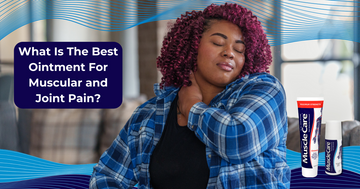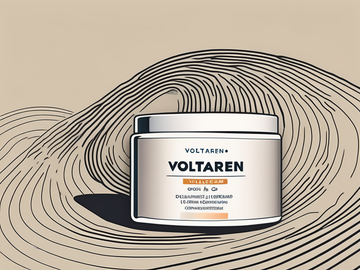
Living with pain can be incredibly challenging and affect every aspect of our lives. Whether it's a nagging muscle ache or a chronic condition, finding relief is a top priority for many. One popular option that has gained widespread recognition is pain relief creams. These topical analgesics offer a targeted approach to managing discomfort, providing much-needed relief when and where we need it most. But how exactly do pain relief creams work? In this article, we will explore the science behind these creams and uncover the secrets to their effectiveness.
Understanding the Science Behind Pain Relief Creams
Before we dive into the specifics of pain relief creams, it's important to understand what causes pain in the first place. Pain is our body's way of signaling that something is wrong or needs attention. When we experience an injury or inflammation, our nerves send pain signals to our brain, resulting in the uncomfortable sensation we're all too familiar with.
Pain relief creams are designed to interrupt this pain signal transmission. They contain active ingredients that work on the skin's surface to provide localized relief, reducing discomfort without impacting other parts of the body. By targeting the source of pain directly, these creams offer a unique advantage over oral medications, which may have systemic effects.
One of the key components in pain relief creams is the active ingredient. Depending on the specific cream, this can vary from menthol and camphor to capsaicin and lidocaine. Menthol and camphor are known for their cooling and numbing properties, providing a soothing sensation to the affected area. Capsaicin, on the other hand, works by depleting a neurotransmitter called substance P, which is responsible for transmitting pain signals to the brain. Lidocaine, a local anesthetic, blocks the nerve signals in the area where it is applied, temporarily numbing the pain.
When pain relief creams are applied to the skin, they penetrate the epidermis and reach the underlying tissues. Once absorbed, the active ingredients interact with the pain receptors in the area, either by blocking the transmission of pain signals or by altering the perception of pain. This localized approach allows for targeted relief, making pain relief creams a popular choice for individuals dealing with muscle aches, joint pain, and minor injuries.
Myodrive™ is a proprietary technology unique to MuscleCare that in our case is a bio-innovation in magnesium absorption with a transdermal delivery system that pushes magnesium through the skin and into the muscles and even as deep as the joints with a targeted, efficient and immediate method to relieve pain, muscle spasm, and inflammation.
MuscleCare uses all-natural ingredients to bind magnesium in our case and nine other ingredients that will work together to create a massive soft-tissue relaxation allowing nutrient-laden circulation to flush into damaged, or painful tissues, that actually push out the inflammatory chemicals that cause pain and tissue damage.
It's worth noting that pain relief creams are not a cure for the underlying condition causing the pain. They are intended to provide temporary relief and should be used in conjunction with other treatments or therapies recommended by healthcare professionals. Additionally, it's important to follow the instructions provided with the cream, including the recommended frequency and amount to apply, to ensure safe and effective use.
In recent years, there has been a growing interest in natural pain relief creams that utilize plant-based ingredients. These creams often contain extracts from herbs such as arnica, ginger, or turmeric, which have been traditionally used for their anti-inflammatory and analgesic properties. While more research is needed to fully understand the efficacy of these natural ingredients, many individuals find them to be a gentle and alternative option for managing pain.
Exploring the Active Ingredients in Pain Relief Creams
The effectiveness of pain relief creams lies in their carefully selected active ingredients. While there are different types of creams available, the most common ingredients include nonsteroidal anti-inflammatory drugs (NSAIDs), counterirritants, and capsaicin.
NSAIDs, such as ibuprofen and aspirin, work by blocking the production of inflammatory chemicals. When applied topically, these drugs penetrate the skin and target the affected area, reducing both pain and inflammation. By inhibiting the enzymes responsible for producing prostaglandins, NSAIDs provide relief for a wide range of conditions, including arthritis, muscle strains, and sprains.
Counterirritants, on the other hand, create a cooling or heating sensation that distracts the brain from the underlying pain. Menthol and camphor are common counterirritants found in pain relief creams. Menthol, derived from peppermint oil, produces a cooling effect by stimulating the cold receptors in the skin. This sensation helps to alleviate mild to moderate pain, such as sore muscles and joint discomfort. Camphor, a natural ingredient derived from the bark of camphor trees, produces a warming sensation that helps to relieve muscle aches and pains.
Lastly, capsaicin, derived from chili peppers, is a unique active ingredient found in certain pain relief creams. Capsaicin works by temporarily depleting a chemical called substance P, which plays a role in transmitting pain signals to the brain. By desensitizing the nerves, capsaicin provides relief for certain types of pain, such as neuropathic pain, osteoarthritis, and post-herpetic neuralgia.
It is important to note that while pain relief creams can be effective for many individuals, they may not work for everyone or for all types of pain. It is always recommended to consult with a healthcare professional before using any new medication or topical cream, especially if you have any underlying medical conditions or are taking other medications.
In addition to their active ingredients, pain relief creams often contain other components that enhance their effectiveness. These may include emollients, which help to moisturize and soften the skin, as well as penetration enhancers, which improve the absorption of the active ingredients into the skin. Some creams also incorporate natural ingredients, such as aloe vera or chamomile extract, known for their soothing properties.
When applying a pain relief cream, it is important to follow the instructions provided by the manufacturer. Generally, a small amount of cream is applied to the affected area and gently massaged into the skin until fully absorbed. It is advisable to wash hands thoroughly after application to avoid accidental contact with sensitive areas, such as the eyes or mouth.
In conclusion, pain relief creams offer a convenient and targeted approach to managing pain. With their carefully selected active ingredients, such as NSAIDs, counterirritants, and capsaicin, these creams provide relief for various types of pain, including inflammation, muscle aches, and neuropathic pain. However, it is always advisable to consult with a healthcare professional before using any new medication or topical cream to ensure its suitability for your specific condition.
The Role of Topical Analgesics in Managing Pain
Pain relief creams fall under the category of topical analgesics. These products work by numbing the area where they are applied, providing temporary relief from discomfort. Unlike oral medications that are absorbed into the bloodstream, topical analgesics primarily target the skin, muscles, and joints. This localized approach allows for targeted relief without exposing the entire body to potentially unnecessary medication.
One of the key benefits of using topical analgesics is their ability to provide targeted relief to specific areas of the body. Whether it's a sore muscle, aching joint, or a sprained ankle, these creams can be applied directly to the affected area, delivering the active ingredients right where they are needed most. This localized approach not only helps to alleviate pain but also reduces the risk of systemic side effects that can occur with oral medications.
Moreover, topical analgesics offer a non-invasive and non-pharmacological alternative to traditional pain management methods. For individuals who prefer to avoid oral medications or are unable to tolerate them due to allergies or other medical conditions, these creams can be a viable option. They provide a convenient and accessible means of pain relief without the need for prescriptions or medical procedures.
Furthermore, the ease of use associated with topical analgesics makes them a popular choice among individuals seeking quick and convenient relief. Unlike injections or invasive treatments, which may require medical supervision or professional administration, pain relief creams can be applied by the individuals themselves. This self-administration not only empowers individuals to take control of their pain management but also allows for immediate relief whenever needed.
In addition to their ease of use, topical analgesics come in various forms, including gels, creams, sprays, and patches. This variety allows individuals to choose the formulation that best suits their preferences and needs. Whether it's a cooling gel for post-workout muscle soreness or a warming patch for chronic joint pain, there is a topical analgesic product available for almost every type of pain.
It is important to note that while topical analgesics can provide temporary relief from pain, they are not intended to treat the underlying cause of the pain. Therefore, it is recommended to consult with a healthcare professional to determine the appropriate course of treatment for any persistent or severe pain.
How Pain Relief Creams Target Specific Areas of Discomfort
One of the key benefits of pain relief creams is their ability to target specific areas of discomfort. Whether it's a sore muscle or a joint affected by arthritis, these creams can be applied directly to the source of pain. The active ingredients in the cream penetrate the skin and underlying tissues, providing relief exactly where it's needed most.
But how exactly do pain relief creams achieve this targeted relief? Let's dive deeper into the science behind it.
When you apply a pain relief cream to your skin, it undergoes a process called transdermal absorption. The cream's active ingredients, such as menthol or capsaicin, work their way through the layers of your skin and into the underlying tissues.
Once the active ingredients reach the affected area, they interact with the nerve endings responsible for transmitting pain signals to your brain. By blocking these signals or reducing their intensity, the cream effectively alleviates the discomfort you're experiencing.
Moreover, pain relief creams often contain additional ingredients that enhance their effectiveness. For example, some creams include anti-inflammatory compounds like arnica or turmeric, which help reduce swelling and inflammation in the targeted area.
Another advantage of pain relief creams is their ability to provide controlled and localized targeting. Unlike oral medications that are distributed throughout the body, creams can be precisely applied to smaller areas. This feature is particularly beneficial for those experiencing localized pain, as it eliminates the need to treat the entire body with medication when only a specific area is affected.
MuscleCare Extra-Strength Roll-On features MyoDrive, an innovation in pain relief that drives magnesium directly into the muscles, therefore reducing pain, restoring muscles to their normal resting state and providing relief for 6-24 hours. Muscles hold the root cause to chronic pain. This is why MuscleCare addresses and often fixes the cause, not just temporarily masking the pain. There is no other topical or subtropical pain relief product that has clinical trials to show that it is the best one in the market. Massage therapists rave about it because they are able to address their clients pain so much quicker and completely.
Furthermore, the localized targeting of pain relief creams allows for a more efficient use of active ingredients. Since the cream is applied directly to the source of pain, a smaller amount of the active ingredients is needed compared to oral medications. This not only reduces the risk of potential side effects but also makes pain relief creams a cost-effective option in the long run.
It's important to note that while pain relief creams can provide effective relief for many individuals, they may not be suitable for everyone. Certain skin conditions, allergies, or sensitivities may prevent some individuals from using these creams. It's always recommended to consult with a healthcare professional before incorporating any new pain relief products into your routine.
In conclusion, pain relief creams offer a targeted approach to managing discomfort. Through transdermal absorption and the interaction with nerve endings, these creams provide relief exactly where it's needed. Their ability to be precisely applied to smaller areas and the inclusion of additional beneficial ingredients make them a popular choice for localized pain relief. However, it's essential to consider individual circumstances and seek professional advice when considering pain relief options.
The Benefits of Using Pain Relief Creams over Oral Medications
While oral medications have their place in pain management, pain relief creams offer unique benefits that make them a preferred choice for many. One notable advantage is the reduced risk of systemic side effects. When oral medications are ingested, they can affect various parts of the body, sometimes resulting in unwanted side effects. Pain relief creams, on the other hand, primarily act on the surface of the skin, minimizing systemic exposure and potential adverse reactions.
Pain relief creams also offer the advantage of immediate relief. Unlike some oral medications that require time to be absorbed into the bloodstream, creams provide direct relief upon application. This convenience makes them an attractive option for those seeking fast-acting relief or those who may have difficulty swallowing pills.
In addition to their localized action and quick relief, pain relief creams often contain ingredients that provide additional benefits to the skin. Many creams are formulated with moisturizing agents, such as aloe vera or shea butter, which can help hydrate and nourish the skin. This dual action of pain relief and skin care makes these creams a popular choice for individuals with dry or damaged skin.
Furthermore, pain relief creams can be applied directly to the affected area, allowing for targeted treatment. This targeted approach is particularly beneficial for localized pain, such as muscle strains or joint inflammation. By applying the cream directly to the source of pain, individuals can experience more focused relief, without affecting other areas of the body.
Another advantage of pain relief creams is their versatility in application. Unlike oral medications that may have restrictions on dosage or frequency, creams can be applied as needed, providing flexibility in pain management. Whether it's a mild ache or a more severe pain, individuals can adjust the amount of cream applied to suit their needs, ensuring personalized and tailored relief.
Moreover, pain relief creams often have a pleasant scent or cooling effect, which can enhance the overall experience of pain relief. The soothing aroma or refreshing sensation can contribute to a sense of relaxation and well-being, creating a more holistic approach to pain management.
Lastly, pain relief creams are generally well-tolerated and have a low risk of interactions with other medications. This makes them a suitable option for individuals who are already taking multiple medications or have underlying health conditions. By choosing a pain relief cream, individuals can minimize the potential for drug interactions and complications.
Debunking Common Myths about Pain Relief Creams
With the popularity of pain relief creams, myths and misconceptions often arise. Let's take a moment to address and debunk some of the common misconceptions surrounding these topical analgesics.
- Myth #1: Pain relief creams are only a placebo. While the effectiveness of pain relief creams varies depending on the individual and the specific condition, numerous scientific studies support their efficacy.
- Myth #2: Pain relief creams are addictive. Unlike certain oral medications that may carry a risk of dependence or addiction, pain relief creams are not addictive. However, it's important to use them as directed and avoid excessive, prolonged use.
- Myth #3: Pain relief creams are only temporary. While pain relief creams provide temporary relief, this can be incredibly valuable for managing acute or short-term pain. For more chronic conditions, regular and timely application of these creams can significantly improve comfort and quality of life.
Choosing the Right Pain Relief Cream for Your Needs
When it comes to selecting a pain relief cream, it's essential to consider your specific needs and preferences. With a wide variety of options available, finding the right cream can make a significant difference in your pain management journey.
MuscleCare Extra-Strength Roll-On features MyoDrive, an innovation in pain relief that drives magnesium directly into the muscles, therefore reducing pain, restoring muscles to their normal resting state and providing relief for 6-24 hours. Muscles hold the root cause to chronic pain. This is why MuscleCare addresses and often fixes the cause, not just temporarily masking the pain. There is no other topical or subtropical pain relief product that has clinical trials to show that it is the best one in the market. Massage therapists rave about it because they are able to address their clients pain so much quicker and completely.
First and foremost, consider the type of pain you are experiencing. Different creams are formulated to target specific types of pain, such as muscle aches, joint pain, or neuropathic discomfort. Additionally, take into account any sensitivities or allergies you may have to certain ingredients. Always read the label carefully and consult with a healthcare professional if you have any concerns or uncertainties.
Tips for Maximizing the Effectiveness of Pain Relief Creams
To make the most of your pain relief cream, keep these tips in mind:
- Apply a thin, even layer: Using too much cream may not improve the effectiveness and can lead to wastage.
- Clean and dry the area: Ensure the application site is clean and dry before applying the cream to maximize absorption.
- Massage gently: Rub the cream into the skin using gentle circular motions, aiding in absorption.
- Follow the recommended frequency: Pain relief creams often have specific instructions regarding application frequency. Adhere to these guidelines for optimal results.
The Future of Pain Relief Creams: Innovations and Advancements
As science and technology continue to advance, so does the field of pain relief creams. Researchers are constantly striving to improve existing formulations and develop innovative approaches to pain management. From enhanced drug delivery systems to novel active ingredients, the future holds promising advancements in pain relief creams.
One area of interest is the integration of natural ingredients. Many pain relief creams already incorporate herbs, such as arnica or turmeric, known for their anti-inflammatory properties. These natural alternatives offer a potentially safer and more holistic option for those seeking relief.
In conclusion, pain relief creams offer a targeted and convenient solution for managing discomfort. By understanding their science, exploring active ingredients, and debunking myths, we can make informed choices in our quest for relief. Whether you're dealing with a minor muscle ache or a chronic condition, a well-chosen pain relief cream may provide the much-needed comfort you deserve.




